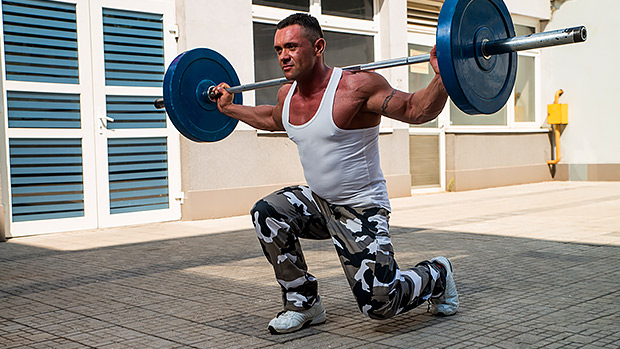"I have knee problems."
"My legs are still sore from last week."
"I'm going out tonight so I can't hit legs."
When it comes to doing lunges, suddenly everyone has an excuse. At best, lunges are performed as an afterthought. Instead of attacking some brutal single-leg work, many lifters would rather sit on the leg extension and text their girlfriend. This is the way of the weakling. If you're in pursuit of strength, lunges should be an integral part of your training.
Why? Because the exercises we hate doing are usually the ones we should be doing. Here are four variations to try:
Any exercise that requires an overhead position automatically puts more demand on your core to stabilize the spine, as long as it's performed optimally.
This lift in particular is beneficial for weightlifters as it strengthens the jerk position.
You can either do the overhead press between each lunge or take the press out and do overhead lunges.
Repeat for 2-3 sets of 6-8 reps each side.
Credit goes to Joe DeFranco for this one. The training benefits here lie within the band set-up and emphasis on power output.
Use relatively heavy dumbbells and emphasize exploding up through each rep. While most lunge variations train hip extension on the moving leg, this variation incorporates hip flexion as well.
Do 3-4 sets of 5-7 reps each leg.
Whether you're doing curls or triceps pushdowns, most exercises are done in the sagittal plane. Overemphasizing one plane of movement and neglecting others is a recipe for disaster, typically resulting in pain or injury.
Lateral lunges reside in the frontal plane and offer training benefits from glute engagement to hip and adductor strengthening.
Start with your feet outside shoulder-width apart and your legs locked. Initiate the lunge by pushing your hips back and sitting on your heel. You should hinge forward slightly, as long as you're maintaining spinal alignment.
Think "heavy heel" and "pushing through your glute" and repeat on the other side.
Do 8-10 reps each side for 2-3 sets.
Holding the dumbbell in your right hand, hinge forward and bring your right leg up until your torso is near parallel with the floor. Bring your feet back together and lunge back with the same leg.
Contralateral loading (holding the dumbbell in your right hand and balancing on your left leg) offers better balance and mimics a natural gait motion.
Do 2-3 sets of 6-10 reps each side.
- Mental toughness: There's something to be said about sets that don't have an immediate finish line. Amping yourself up for 5 squats is a lot easier than amping yourself up for 8 heavy lunges on each leg. That takes mental toughness.
- Increased loading: Mike Boyle said it perfectly regarding squats versus lunges: "...athletes' legs could handle far more weight than their backs were capable of transmitting. This suggests that the back is the weak link in squatting. Bypass the back, and your legs can handle much heavier weights."
- No spinal loading: You don't need to load a bar on your back to get stronger. Holding dumbbells at your sides or in a goblet position during lunges puts less wear and tear on your back while retaining all the leg training benefits. Even if you do lunges in a back-rack position, the split stance puts less demand on the hips and is "easier" to perform optimally as opposed to back-loaded barbell squats.
- Correct imbalances: Bilateral movements allow you to see your imbalances and unilateral movements allow you to correct them.
- Core strength: Stand on one leg and notice what happens: you've gotta work harder to balance. Now stand with one foot in front of the other in a lunge stance – same thing. You've gotta work harder to balance! Your core is your center of gravity and the demand is greater during lunges as opposed to their bilateral counterparts.
- Metabolic training: More calories burned doesn't equate to an effective workout, but it does offer benefits from a fat loss and metabolic perspective. More muscles working means more impact on your body and performance.





